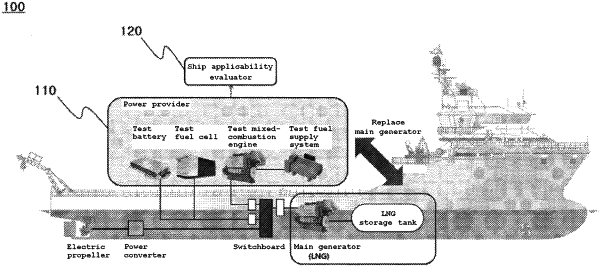| CPC B63H 21/17 (2013.01) [G01M 10/00 (2013.01); G01M 15/04 (2013.01); H01M 8/04313 (2013.01); B63H 2021/003 (2013.01); B63H 2021/205 (2013.01)] | 6 Claims |

|
1. A marine testbed for providing marine verification and securing a track record of an eco-friendly propulsion system for a ship, the marine testbed comprising:
a power provider connected to a main generator of the ship equipped with an electric propulsion system, and provided to be used as a propulsion power source of the ship, replacing power production from the main generator; and
a ship applicability evaluator performing one or more ship application tests in a propulsion process of the ship through the power provider and determining whether the power provider is allowed to be used as the propulsion power source of the ship,
wherein the power provider comprises any one or more of the following: one or more fuel cells; a battery; a zero-carbon fuel engine; and a zero-carbon fuel mixed-combustion engine, and the power provider is electrically connected to a DC grid-based distribution board or an AC grid-based distribution board connected to the main generator of the ship,
wherein while the one or more fuel cells of the power provider are connected to the DC grid-based distribution board, when power is provided replacing the power production from the main generator, the ship applicability evaluator measures and records output stability, a fuel consumption rate, temperature, and humidity of the one or more fuel cells,
wherein while the battery of the power provider is connected to the DC grid-based distribution board, when power is provided replacing the power production from the main generator, the ship applicability evaluator measures and records output stability, a fuel consumption rate, temperature, and humidity of the battery,
wherein when the zero-carbon fuel engine or the zero-carbon fuel mixed-combustion engine of the power provider provides power replacing the power production from the main generator, the ship applicability evaluator acquires information on a cooling water temperature, a lubricating oil temperature, and RPM from a machinery control system (MCS) connected to the main generator,
wherein when the zero-carbon fuel engine or the zero-carbon fuel mixed-combustion engine of the power provider provides power replacing the power production from the main generator, the ship applicability evaluator acquires information on whether fuel slip has occurred and on exhaust material emission from one or more sensors pre-installed in the ship,
wherein the main generator includes two main generators, and
wherein the ship application evaluator is installed at the ship and connected to only one of the two main generators on two axes of the ship.
|